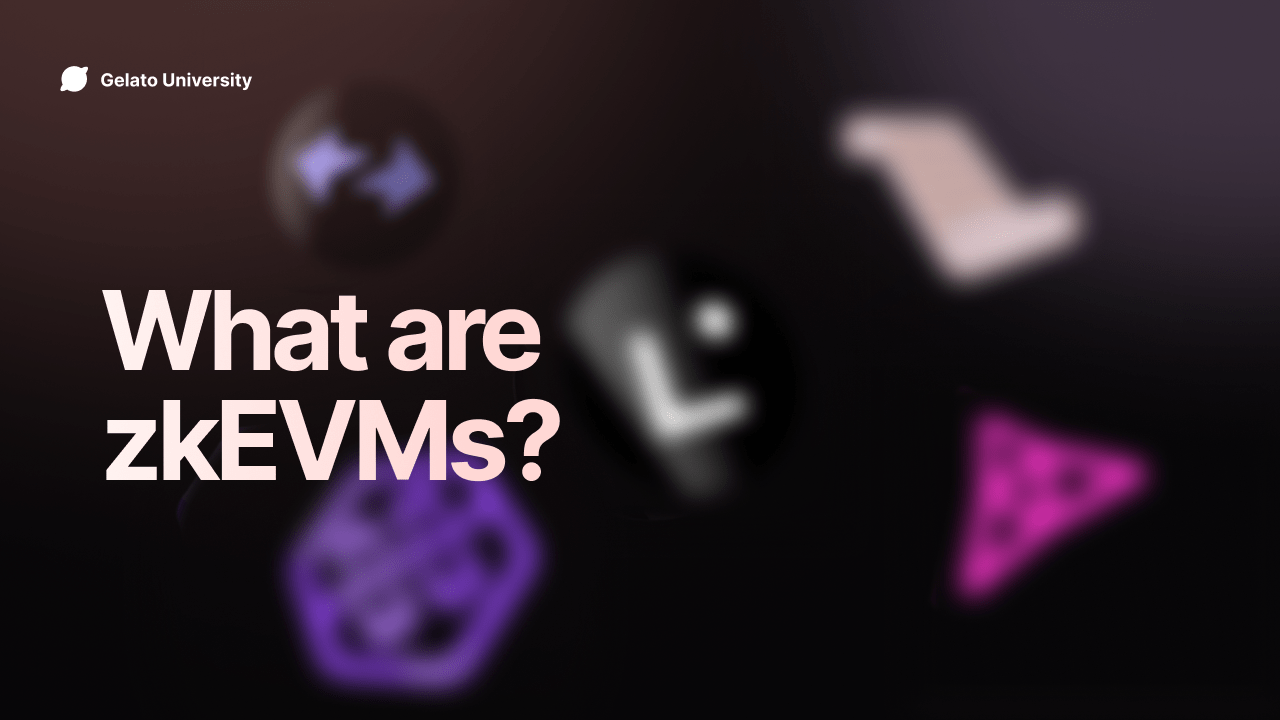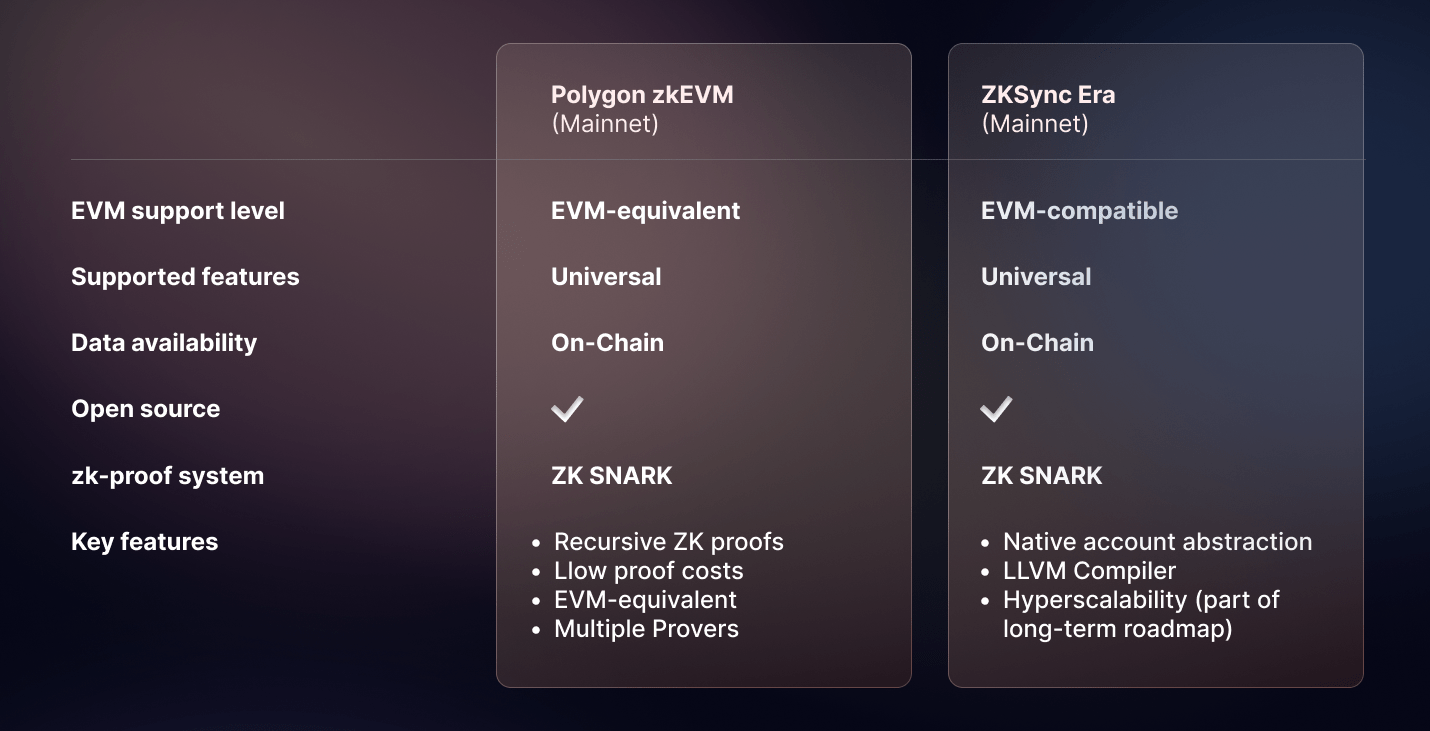761 days ago
Buidling the Future: Projects Leading the Charge in Zero-Knowledge Technology

Scalability is a challenge for Ethereum, leading to the emergence of Layer-2 solutions like ZK rollups. However, ZK rollups didn't support smart contracts until zkEVMs came along. They combine the EVM's functionality with zero-knowledge proofs for scalability. Check out our earlier content on the topic here. This post highlights several promising zkEVM projects: Polygon's zkEVM, zkSync Era, Scroll, Linea(ConsenSys Zkevm), and Taiko.
If you're new to the concept of zkEVMs or want to refresh your memory, we also have an article that provides an in-depth explanation of what zkEVMs are and how they work.
Polygon ZKEvm
Polygon's zkEVM Beta is a scaling solution equivalent to the Ethereum Virtual Machine (EVM). It allows developers to build applications using the vast majority of existing smart contracts, tools, and infrastructure they use on Ethereum.
It can process hundreds of transactions in a batch in less than two minutes, and has proof costs for large batches of transactions as low as $0.06.
Polygon zkEVM Features:
Batch Aggregation: The Sequencer collects user transactions and groups them in batches, which are then sent to the zkProver for processing in the Polygon zkEVM.This optimised batch aggregation includes more transactions per batch, enhancing system efficiency
Recursion: When a user submits a batch of transactions to be processed, each transaction is verified using a ZK proof to ensure it is valid. With the introduction of recursion in Polygon zkEVM, a single validation proof can now be used to verify multiple other proofs
Multiple provers: This optimizes gas throughput with larger batches and supports parallel processing by multiple provers, preventing bottlenecks and enhancing system performance
FFLONK protocol: used in ZK-SNARK, FFLONK improves the performance of the verifier and doesn't require a specific trusted set-up, enhancing security, accessibility, and trustworthiness. It also requires less computational effort than other protocols
Development: The Polygon zkEVM launched its public testnet in October 2022, followed by a final testnet in December 2022 that included performance and scalability upgrades. In March 2023, Polygon zkEVM launched its mainnet beta, enabling developers to use the same code, tools, and infrastructure as Ethereum, but with faster and cheaper transactions.
During the mainnet beta launch, Ethereum founder Vitalik Buterin performed the first token transaction on the network.
https://zkevm.polygonscan.com/tx/0x18db0b46e46777b5b369460be229b0704abe7d24bf88dbfee99054c43b0c121c
zkSync
ZkSync was created by blockchain engineering and research team, Matter Labs that addresses Ethereum's scalability issues by utilizing ZK proofs. Their initial product, zkSync 1.0 (zkSync Lite), was a basic ZK rollup created for payments, but lacked support for smart contracts. zkSync 2.0 (aka zkSync Era) was launched with smart contract functionality, allowing developers to deploy smart contracts on the Layer 2 network.
zkSync Era 2.0 features:
LLVM Compiler: zkSync Era is not an exact EVM replica, it is designed to be highly compatible with EVM-based languages. Zksync Era achieved this using LLVM compiler for compatibility with EVM languages, translating high-level code to work in a zero-knowledge environment, allowing developers to use familiar languages and tools on the platform.
Native account abstraction: allows users to pay fees in any tokens or even transact with zero fees
Data compression: Data Compression in zkSync Era shares only state differences, reducing data size for faster updates, better privacy, and easier off-chain storage integration.
zkSync 2.0 also includes a feature called hyperscalability, which is part of their long-term roadmap. Hyperscalability seeks to build unlimited ZK-based networks on Ethereum for faster crypto adoption through connected, scalable systems.
Scroll
Scroll is a Layer 2 scaling solution for Ethereum that uses a zkEVM-based ZK rollup. Scroll launched on the Goerli testnet in February 2023, transitioning from a pre-alpha to an alpha testing phase in their zkEVM development.
Scroll features: EVM Equivalence: Scroll ensures that programs written for the EVM can also run on its platform without any extra work or major changes to the development process. This provides a seamless migration path from existing dapps and developer tooling
Decentralization: Scroll promotes decentralization across many aspects, including node operators, provers, and the developer and user community. It reduces time to finality on Layer 1 by utilizing a decentralised prover network and has a credible commitment to decentralizing both proving and sequencing.
Development of Scroll: Scroll have been working on their zkEVM solution for almost two years, and launched their first pre-alpha testnet in June 2022 in close collaboration with the PSE (Privacy and Scaling Explorations) group at the Ethereum Foundation. The pre-alpha testnet runs on a private PoA fork of Ethereum, with testnet Scroll L2 supporting a Uniswap fork and other demo applications.
With the pre-Alpha Testnet upgrade it enables smart contract deployment on Scroll, allowing developers to write and deploy their own contracts on the network using the same Ethereum developer tools. Users can also bridge NFTs and user-defined ERC-20s between our Layer 1 and Layer 2 testnets on our upgraded bridge contract.
Linea (ConsenSys zkEVM)
Linea, developed by ConsenSys, is a Layer 2 solution for Ethereum that enables scalable and cost-effective decentralized applications. It offers developers an accessible platform for building innovative web3 dApps using high-performance zkEVM technology.
Linea Features: Innovative prover design: Offers self-recursion techniques, which help to reduce the size of proofs, making them more efficient and enables efficient handling of complex queries. This ensures faster transaction speeds and reduced gas costs without compromising on security, and it is also resistant to quantum computers.
EVM equivalent: Linea offers full EVM equivalence, which means that developers can build and run dapps on Linea using the same programming languages and tools as they do on Ethereum's Layer 1. This also means that existing dapps built on Ethereum can easily migrate to Linea without any code changes or smart contract rewrites
Development of ConsenSys: Linea has been actively developed and tested by ConsenSys R&D. They launched a private testnet in January of this year, and within the first few weeks of testing, Linea processed 1.5 million transactions. After months of testing and refinement, ConsenSys R&D launched Linea on a public testnet in March 2023. Along with the launch, they rebranded the ConsenSys zkEVM as 'Linea'.
Taiko
Taiko is an Ethereum-equivalent ZK rollup, scaling Ethereum in a Layer-2 architecture that is decentralized, permissionless, and secure.It emulates Ethereum's technical and non-technical aspects. Taiko supports all EVM opcodes and follows a type-1 zkEVM architecture, prioritizing perfect EVM/Ethereum-equivalence over ZK proof generation speed.
Taiko Features: Ethereum Equivalence: Taiko strives for maximum compatibility with Ethereum. Taiko is a Type1 zkEVM, which means it makes no changes to the Ethereum architecture, whether it be the hash function, state trees, or gas costs. This equivalency allows us to reuse execution clients with minimal modification.
Decentralization: Taiko emphasises decentralization in its design, allowing multiple parties to participate in various network roles, including proposers, provers, and node runners. This helps ensure censorship-resistance and a robust network.
Development of Taiko: Taiko launched the Alpha-1 Testnet in Dec 2022 which allows developers to deploy the smart contracts and use all the existing Ethereum tooling. Interested parties can run an L2 node and even act as a proposer. Taiko operates a private Ethereum PoA fork for its L1 environment on the testnet. It also provides a faucet for requesting ETH and a sample ERC20 token on both L2 and L1, as well as a bridge to move assets between the two levels
They also launched the Alpha-2 Testnet on 23 March, featuring permissionless provers and partial zkEVM circuits.
Polygon's zkEVM vs zkSync

About Gelato
Gelato is a Web3 Cloud Platform empowering developers to create automated, gasless, and off-chain-aware Layer 2 chains and smart contracts. Over 400 web3 projects rely on Gelato for years to facilitate millions of transactions in DeFi, NFTs, and gaming.
-
Gelato RaaS: Deploy your own tailor-made ZK or OP L2 chains in a single click with native Account Abstraction and all Gelato middleware baked in.
-
Web3 Functions: Connect your smart contracts to off-chain data & computation by running decentralized cloud functions.
-
Automate: Automate your smart contracts by executing transactions automatically in a reliable, developer-friendly & decentralized manner.
-
Relay: Give your users access to reliable, robust, and scalable gasless transactions via a simple-to-use API.
-
Account Abstraction SDK: Gelato has partnered with Safe, to build a fully-fledged Account Abstraction SDK, combining Gelato's industry's best gasless transaction capabilities, with the industry's most secure smart contract wallet.
Subscribe to our newsletter and turn on your Twitter notifications to get the most recent updates about the Gelato ecosystem! If you are interested in being part of the Gelato team and building the future of the Internet browse the open positions and apply here.

